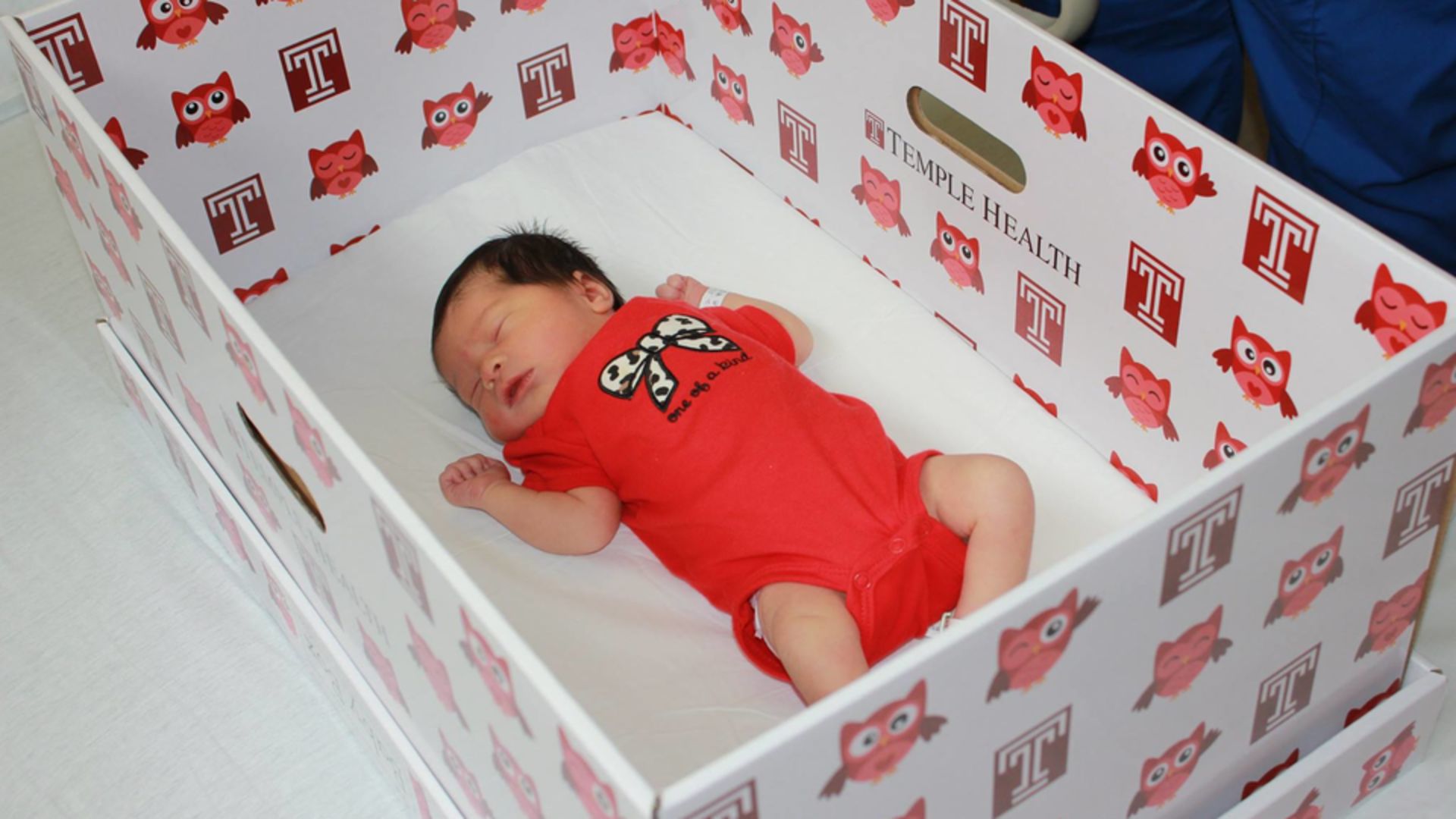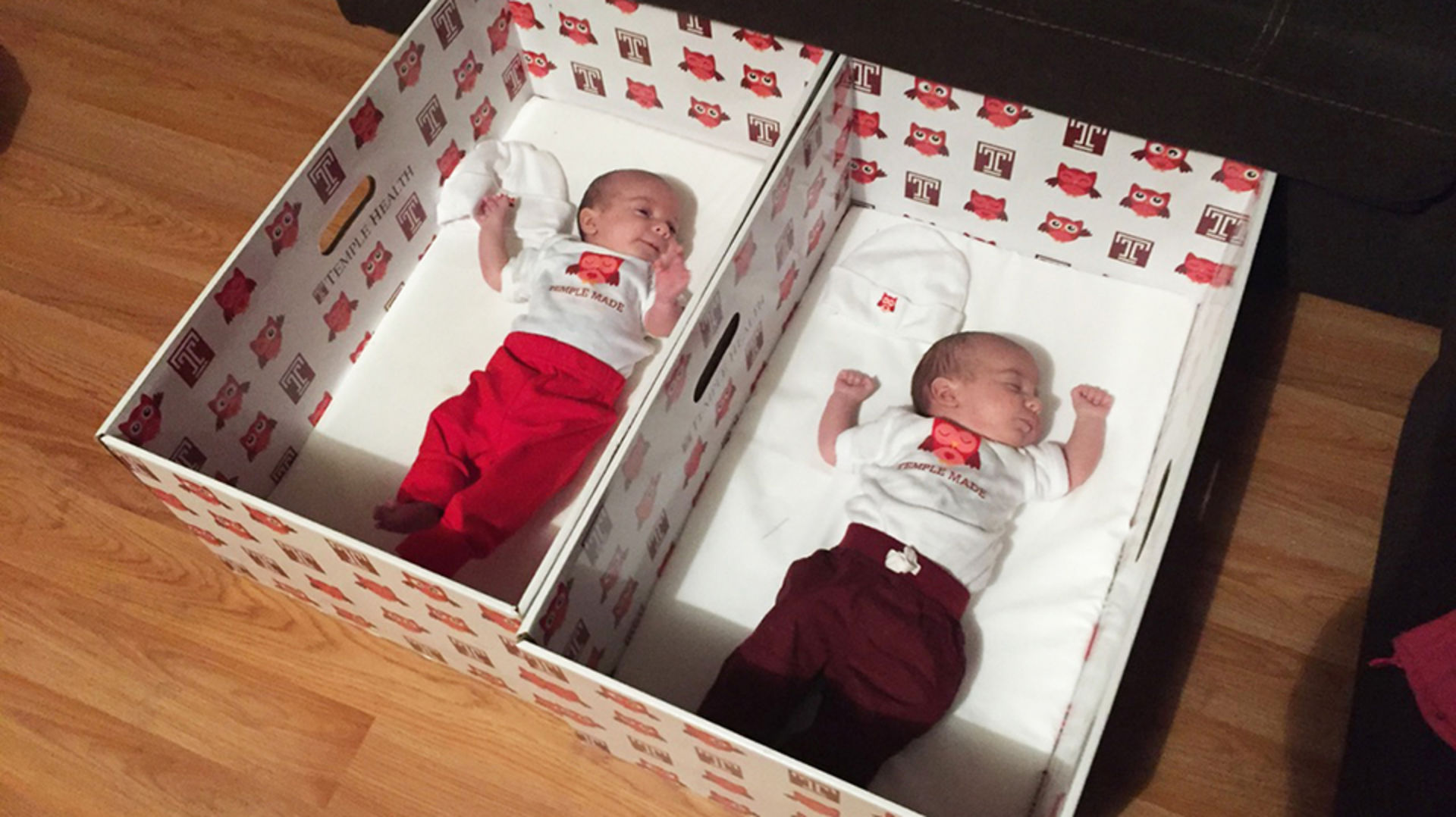This is How Inspiration Strikes: the Story Behind and Impact of Temple’s Baby Boxes

Temple’s Baby Box program began in May 2016. Each month, a tractor-trailer arrives with 250 boxes.
In 2013, Dr. Megan Heere, Medical Director of the Well Baby Nursery at Temple University Hospital, received data from the city that for every 1,000 live births in Philadelphia, nearly 10 babies died in their first year.
Across Pennsylvania, the rate was much lower, fewer than 7 infant deaths per 1,000 births.
At the same time, Dr. Heere’s professional organization, the American Academy of Pediatrics, was warning that the number of infants sleeping with an adult and being accidentally smothered appeared to be increasing.
And nationally, African American babies were twice as likely to die from sleep-related deaths as whites.
Finally, in the fall of 2013, Dr. Heere read a BBC News story about a baby box program in Finland, started in the 1930s when that country was poor and infant mortality high. The concept was simple: give every newborn a box, and fill it with supplies the new mother can use.
Dr. Heere’s brainstorm: Why not give baby boxes to Temple mothers?
She went on Google and searched for a way to order baby boxes from Finland. “You just can’t,” she said. “They’re under lock and key.”
She found a small company in California selling baby boxes, she said, “as a unique European style baby gift starting at like $110.”
“I have 3,000 North Philly mothers and need a place for their babies to sleep safely,” she emailed the company. “What can we do on a price?”
This was the beginning of a 2½ year odyssey to become the first hospital in America to give away baby boxes.
“I had sleepless nights,” Dr. Heere said. “I was afraid somebody else was going to beat us to it.”
• • •

Dr. Heere (left) discusses Temple’s Baby Box program.
She teamed with Jennifer Rodriguez, Director of Nursing Services, and Lorna Braunsar, nursing manager in the maternity, and they became the program’s Three Musketeers.
All they needed to do was convince top administrators, lawyers and risk managers this was a good idea, and to find the money.
“To implement something in a hospital is very difficult,” Dr. Heere said, “but we were never met with anything negative. Everybody saw it and liked it. It shows our commitment to the community.”
The administration not only approved the idea but kicked in hospital money.
Victoria Vicente, with the medical school’s office of institutional advancement, did a crowd funding campaign one year within Temple and generated $5,000 within hours, and $24,000 after six weeks.
The Kellogg Foundation paid for the boxes, mattresses, and shipping to get them here — about $31 per box.
Kohl’s Cares for Kids Foundation kicked in money to buy things to go into each box — wearable blankets, nasal suction bulb, wipes, diapers, baby wash, thermometer , books, hat, socks, Temple t-shirt and more.
In all, it costs about $100 per box.
The program began in May 2016. Each month a tractor-trailer arrives with 250 boxes, which are unloaded and stored in the hospital’s basement.
“We had prepared the central supply guys,” Dr.Heere says, “and they were wonderful. So they line them up in the garage. Every night, the night employee from central supply brings about 10 boxes to the maternity unit and stacks them neatly.”
Every three months, Dr. Heere hosts a pizza party in the hospital basement and students, nurses, doctors and staff, in an assembly line production, stuff 750 bags that go into the baby boxes.
Rodriguez and Braunsar have played vital roles. Rodriguez arranged the collaboration of multiple departments and oversaw the purchasing and shipping of the boxes and contents.
Braunsar improved the educational component. Every family is instructed about safe sleep before going home. Braunsar also handled day-to-day box distribution.
In addition to rolling out the baby box program, Temple is in the middle of changing its approach to the hospital nursery, keeping babies in the hospital room with mothers so they can bond more, learn good habits, develop good rhythms. A goal is to encourage safe sleep habits and breastfeeding.
“We’re keeping moms and babies together as much as possible,” said Dr. Gail Herrine, an obstetrician and lifelong breastfeeding advocate. “Skin to skin, learn the feeding …If mothers bond, they’re much more likely to care for the baby better.”
• • •
When Dr. Heere conceived the idea of the boxes, her boss, Dr. Stephen Aronoff, the pediatrics department chair, urged her to include a research component. Don’t just give boxes out, he said, but measure if they’re having an impact.
In 2014, Dr. Heere learned Temple has a call center, the Temple Access Center, which conducts surveys of Temple patients. She asked them (and brought donuts) to add questions about infant safe sleep to their current script.
The study was done in two parts.
The first part, from January to October of 2015, was based on current practices in the hospital at the time. There was some sleep education given to parents before they left, but not nearly as extensive as now.
The second part began a year ago, with the distribution of the boxes. Temple also rolled out its much-improved education of mothers in the hospital about safe sleep habits.
The first results from the study are complete but confidential, under review for publication in a medical journal.
• • •

The first set of twins to receive boxes from Temple’s program were Justin and Greyson Rodriguez.
Dr. Heere’s sleepless nights were not for naught.
Temple was the first hospital in America to give away baby boxes, and Temple’s program made worldwide news — national television networks, newspapers across the globe — it was an internet sensation. Dr. Heere is still fielding calls from around the country, often from hospitals who want to start a program.
“I’m happy, definitely happy,” said Dr. Heere. “Also humbled. The feedback I receive from families, the community and the other box programs around the country has been overwhelmingly supportive and positive. I’m also excited to see the program evolve.”
The first set of twins to receive boxes were Justin and Greyson Rodriguez, born Oct. 15.
In December, they were living with their parents, Cynthia and Gabe Rodriguez, in a two-bedroom apartment off Lehigh Avenue.
During a visit at that time, when the twins were eight weeks old, the baby boxes had held up well and looked good as new — which was surprising, considering how popular they were.
When one of the boxes was empty, the twins’ older brother, Alex, 1, often climbed in and took a nap. Big sister Julia, 3, road tested them a bit, too, kicking the sides, jumping in them, playing with her twin brothers.
“I would have thought they would have been destroyed,” the father said. “The kids play a lot in there.”
The babies slept at night in a Pack ’n’ Play upstairs. But during the day, downstairs, they spent much of their time in the baby boxes, usually near the living room couch.
Even though the program got worldwide attention, many people living near the hospital still had never heard of it.
“A lot of people come here to see our kids,” explained Gabe. “And the first impression they have is `Oh my God. They’re in boxes!’ ”
“A lot of people are kind of lost when they see it,” added Cynthia.
“But then we explain it to them,” said Gabe. “And they love it.”
Cynthia said she loved the boxes for many reasons — but especially convenience.
She spent the first four weeks with the twins at her mother’s and brought the boxes with her. She hoped that when her twins, about 7.5 pounds before Christmas, outgrew the boxes, she could use them for storage.
The Rodriguez twins are identical.
Gabe was holding one in his lap — but had no idea which one.
“My mom swears she knows,” Cynthia said in December, “but I just can’t get it.”
“I take guesses,” added Cynthia, “but the only way I actually know how to tell them apart is if I strip them. They have a birthmark on their back. One has a bigger birthmark than the other one. It’s in the same place, but one is bigger.”
“I took them to their appointment last week and got it all mixed up,” said Gabe in December. “I came home and said, `Justin has the little one, right?’ She says no, `Greyson does’.”
“We had to call the doctors back and tell them to switch the information.”

Cynthia and Gabe Rodriguez with their twins. The Rodriguez family loves the boxes for many reasons.
Post Script: There were a few nights over the winter when one of the babies would get sick, and fuss, and the parents would bring the box into bed between them. “It was so much easier than constantly getting out of bed,” said Cynthia, “and I felt they were safe in the box.”
By the beginning of March, she said, the older two kids were using the boxes as playhouses, and forts, and carrying them around the house over their heads.
The boxes were simply loved to death and taken to the curb.
• • •
Michael Vitez, winner of the 1997 Pulitzer Prize for Explanatory Journalism at The Philadelphia Inquirer, is the director of narrative medicine at the Lewis Katz School of Medicine at Temple University. Michael.vitez@temple.edu
